
Magnetic Responsive Polymer Composite Materials
October 23, 2013
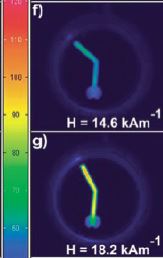
Magnetic responsive materials are the topic of intense research due to their potential breakthrough applications in the biomedical, coatings, microfluidics and microelectronics fields. By merging magnetic and polymer materials one can obtain composites with exceptional magnetic responsive features. Magnetic actuation provides unique capabilities as it can be spatially and temporally controlled, and can additionally be operated externally to the system, providing a non-invasive approach to remote control.
The authors identified three classes of magnetic responsive composite materials, according to their activation mode and intended applications, which can be defined by the following aspects. (A) Their ability to be deformed (stretching, bending, rotation) upon exposure to a magnetic field. (B) The possibility of remotely dragging them to a targeted area, called magnetic guidance, which is particularly interesting for biomedical applications, including cell and biomolecule guidance and separation. (C) The opportunity to use magnetic induction for thermoresponsive polymer materials actuation, which has shown promising results for controlled drug release and shape memory devices. For each category, essential design parameters that allow fine-tuning of the properties of these magnetic responsive composites are presented using key examples.
Otomagnetics Receives Inaugural Rybski MedTech Award
October 05, 2013
.jpg) Washington, DC - On October 1, 2013, the Advanced Medical Technology Association (AdvaMed) announced that Otomagnetics – a start-up firm that has developed a “magnetic syringe” that directs therapy to hard-to-reach locations – has been awarded the inaugural Virginia Shimer Rybski Memorial Award, recognizing the potential of a promising entrepreneur or entrepreneurial company. This award is worth $10,000.
Washington, DC - On October 1, 2013, the Advanced Medical Technology Association (AdvaMed) announced that Otomagnetics – a start-up firm that has developed a “magnetic syringe” that directs therapy to hard-to-reach locations – has been awarded the inaugural Virginia Shimer Rybski Memorial Award, recognizing the potential of a promising entrepreneur or entrepreneurial company. This award is worth $10,000.
Otomagnetics, a University of Maryland-College Park start-up, is commercializing a platform technology to minimally-invasively direct therapeutic payloads to hard-to-reach anatomical targets. The first target for the company’s proprietary magnetic delivery system is the middle and inner ear, to treat conditions such as sudden hearing loss, tinnitus and middle ear infections. Other potential markets include drug delivery to the eye, the dental market, and neuro-degenerative diseases.
Otomagnetics was chosen to receive the first-ever Virginia Shimer Rybski Memorial Award since “the company focused on a specific clinical issue with a significant unmet need,” said award judge Dr. Jeffrey Hausfeld, chairman and founder of the Society of Physician Entrepreneurs. “We appreciate the science of non-invasively directing bio-compatible nano-particles and payloads through tissue in order to bring therapeutics to hard-to-reach targets such as the inner ear. The judges appreciated the fact that this is a novel, platform technology and that Dr. Shapiro did an excellent job at conveying the promise of a very useful clinical device that will hopefully improve patient care and outcomes.”
The technology was developed by a team of researchers led by Dr. Benjamin Shapiro at the Fischell Department of Bioengineering and the Institute for Systems Research, at the University of Maryland at College Park. Financial support was provided by the State of Maryland including the Technology Development Corporation and Maryland Industrial Partnerships, as well as from the UK-based Action on Hearing Loss and the Sheikh Zayed Institute for Pediatric Surgical Innovation at Children’s National Health System in Washington, DC.
“Our goal is to move our magnetic delivery technology from the lab to the market so that it can help patients,” said Dr. Shapiro. “To have a panel of experts, from clinicians to investors and regulatory advisors, see the potential of our approach and award us the first-ever Virginia Shimer Rybski prize, that is a distinction and an honor for us. It will certainly aid our efforts to develop this technology.”
Stem Cell Extraction Technique Uses Magnets
October 03, 2013Neural stem cells have been magnetically extracted from a rat's brain without harming the rodent, offering hope that the procedure can be used to harvest stem cells from humans. Edman Tsang of the University of Oxford developed a technique in which magnetic nanoparticles coated with antibodies that cling to neural stem cells are injected into the lateral ventricles of the rats' brains. After the nanoparticles attach themselves to the stem cells, a magnetic field around the rats' heads pulls the cells together so they can be extracted with a syringe.
For more details: Check here.
Smartphone Takes Fluorescent Nanoparticle Pictures
October 02, 2013
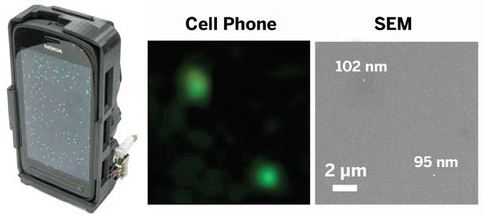
The device, designed by Aydogan Ozcan of UCLA and colleagues, consists of a laser diode to excite fluorescent dyes and a compact system of lenses and filters that remove background noise created by the laser light. The team used the microscope to detect human cytomegalovirus particles, which are between 150 and 300 nm in diameter, and polystyrene beads, which at about 100 nm in diameter were the smallest objects that could be detected. According to Ozcan, the mini microscope is the first portable, cell-phone-based imaging system sensitive enough to resolve individual nanoparticles and viruses. Ozcan started a company called Holomic to commercialize the device, and his group has created smartphone apps for data analysis.
Successful Meeting - Frontiers in BioMagnetic Particles III
August 29, 2013The Frontiers in BioMagnetic Particles III meeting was held in the idyllic location of Telluride CO, with participants from 9 different countries. A wide range of high quality invited and contributed talks were given on subjects including monodispersed nanoparticle fabrication, MRI and MPI imaging, drug delivery, magnetically modulated energy delivery (MagMED), and magnetically actuated materials. There was also a career development panel with participants from large industry and startup companies, government labs and agencies (NIST, Sandia, and NCI), and academia. Every session included a panel discussion on challenges and opportunities, with all participants in the session serving as panelists. Poster sessions were held outside with delicious food and drinks catered by the Telluride Sceience Research Center (TSRC) staff. The event provided excellent networking opportunities; social activities during and around the meeting included hiking, biking, gold panning, and ballooning. Overall the meeting was a great success!
To checkout the program, see here. And if you have questions about it or want to get on their mailing list, then please contact Thompson Mefford and Jeffrey Anker who organized the meeting flawlessly in one of the most scenic places! Their next meeting will take place in 2015. And now a few pictures from the meeting.
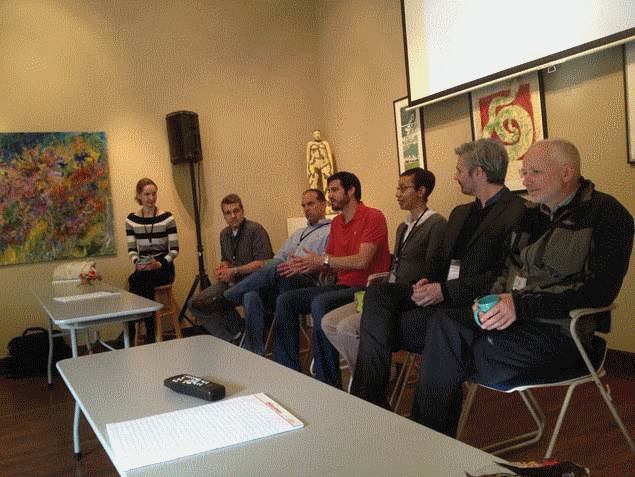
Varying Ferromagnetism in a Single Material
August 15, 2013Researchers at the Paul Scherrer Institute have managed to grow a material that is simultaneously ferromagnetic and antiferromagnetic. They grew layers of LuMnO3 on a crystal and found that close to the crystal the material exhibited ferromagnetism, but became antiferromagnetic farther away. The material's structure adapts itself to that of the underlying crystal, which creates this gradient. While varying ferromagnetism has previously been created by layering materials, this is the first time the feat was achieved in a single material. This has implications for the de-sign of compact digital storage media.
http://swissinnovation.org/news/web/2013/04-130712-65
South Korea Testing 'Electric Road' That Charges Buses as They Travel
August 13, 2013

Pick-up equipment underneath the bus, or Online Electric Vehicle (OLEV), sucks up power through non-contact magnetic charging from strips buried under the road surface. It then distributes the power either to drive the vehicle or for battery storage As a result it requires a battery only one-fifth the size of conventional electric vehicles. The system also eliminates the need for overhead wires used to power conventional trams or trolley buses. The technology does not come cheap, with each OLEV costing around $630,000.
"The technology is readily available but the question is how to bring down the cost," said Park Jong-Han, manager of the company that produced the OLEV prototypes. "Once the cost goes down, I believe more cities will be interested in commercialising the new transport network," Park told AFP. The system has already been partially trialled on a much smaller scale at an amusement park and on the KAIST campus.
Electrifying the road does not require major construction work, as the recharging stations only have to be buried along 10-15 per cent of the route at places such as bus stops.
Better Measurement of Single Cell Temperature
August 05, 2013
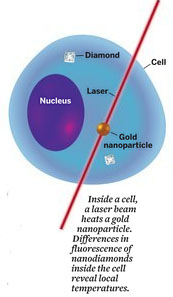 Nanoscale thermometry has untold possible uses for biology, from basic research on how heat flows in living systems, hyperthermia research in magnetic treatments, to controlling gene expression with temperature. Researchers use a number of techniques for biological thermal sensing, including Raman spectroscopy and detection of fluorescing proteins. But all have problems, such as low sensitivity or the inability to make highly localized measurements. Now, a group led by physics professor Mikhail D. Lukin and chemistry professor Hongkun Park at Harvard University have harnessed a common defect in diamonds to develop an improved approach for nanometer-scale thermometry in biological systems ( Nature 2013, DOI: 10.1038/nature12373 ). In some diamonds, two adjacent carbons are replaced by a nitrogen and an empty spot called a nitrogen vacancy center. Minuscule temperature changes strain the lattice of such diamonds, which affects the quantum spin properties of the local defect and modifies its fluorescence properties. These changes can then be detected.
Nanoscale thermometry has untold possible uses for biology, from basic research on how heat flows in living systems, hyperthermia research in magnetic treatments, to controlling gene expression with temperature. Researchers use a number of techniques for biological thermal sensing, including Raman spectroscopy and detection of fluorescing proteins. But all have problems, such as low sensitivity or the inability to make highly localized measurements. Now, a group led by physics professor Mikhail D. Lukin and chemistry professor Hongkun Park at Harvard University have harnessed a common defect in diamonds to develop an improved approach for nanometer-scale thermometry in biological systems ( Nature 2013, DOI: 10.1038/nature12373 ). In some diamonds, two adjacent carbons are replaced by a nitrogen and an empty spot called a nitrogen vacancy center. Minuscule temperature changes strain the lattice of such diamonds, which affects the quantum spin properties of the local defect and modifies its fluorescence properties. These changes can then be detected.
The group used microwave pulses to manipulate a diamond-lattice defect’s spin states,
and from resulting changes in fluorescence, researchers determined corresponding
temperature variations. The method, they found, is capable of detecting temperature
changes as small as 1.8 mK in areas as small as 200 nm across. The team then tested the thermometer in a living human cell, an embryonic fibroblast. They inserted nanodiamonds and gold nanoparticles into the cell. Laser light heated the gold nanoparticles, and the group monitored temperature gradients throughout the cell by observing changes in the nanodiamonds’ fluorescence. “I like this technique very much,” says Xinwei Wang , a mechanical engineering professor at Iowa State University, noting that in addition to being very sensitive, the technique’s spatial resolution is comparable or superior to that of widely used Raman techniques.
“This kind of sensitivity is extremely important when diagnosing thermal responses and studying chemical reactions in biosystems at the cellular level,” Wang says. Konstantin V. Sokolov, a physics professor at the University of Texas, Houston, calls the work “a precious solution” to the problem of measuring temperatures in biological systems on the nanometer scale. With improvement, the team says the technique may make it possible to observe real-time biological activity with subcell resolution.
For more information, check out our Archives.
September 2017
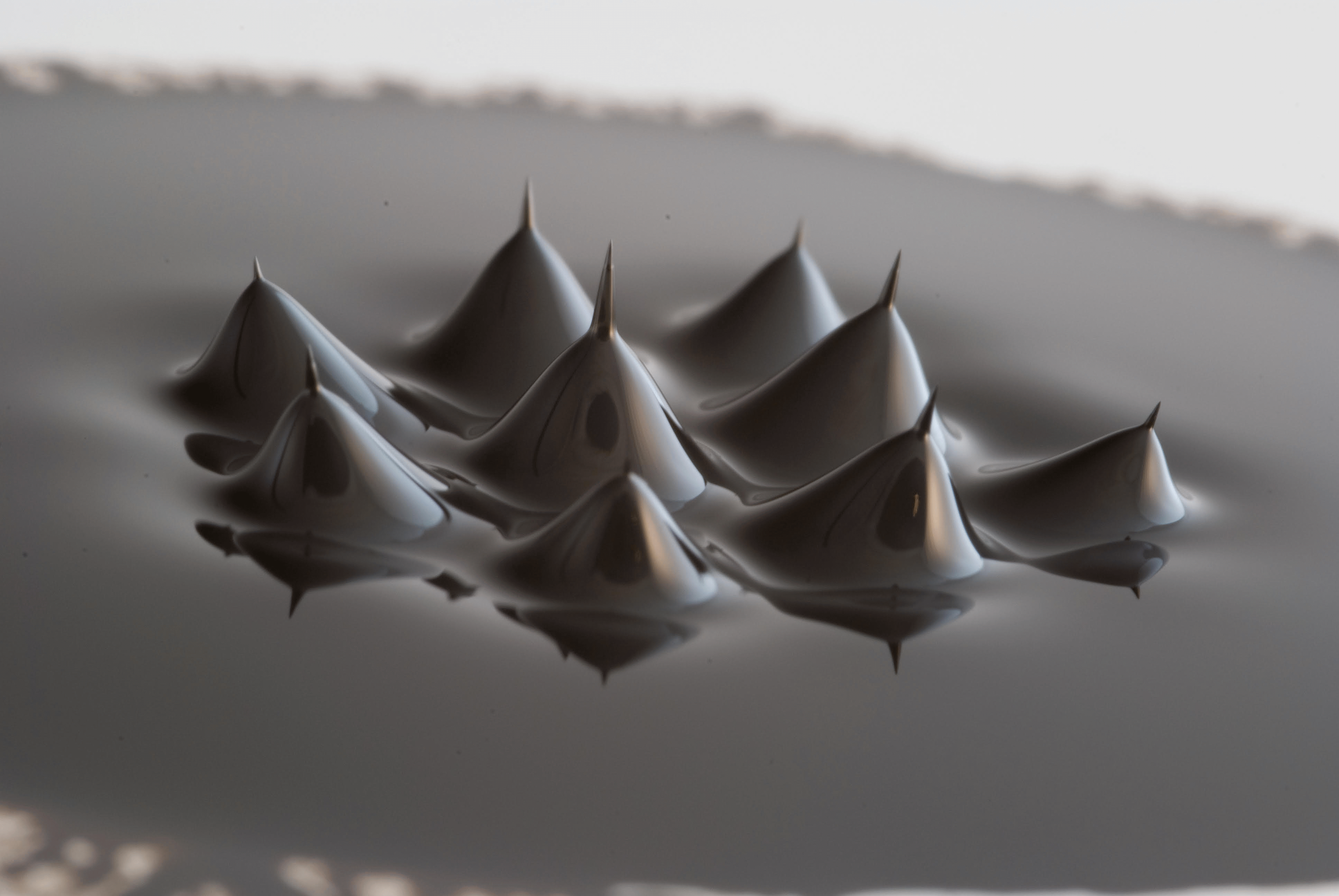
Search this site with the power of
